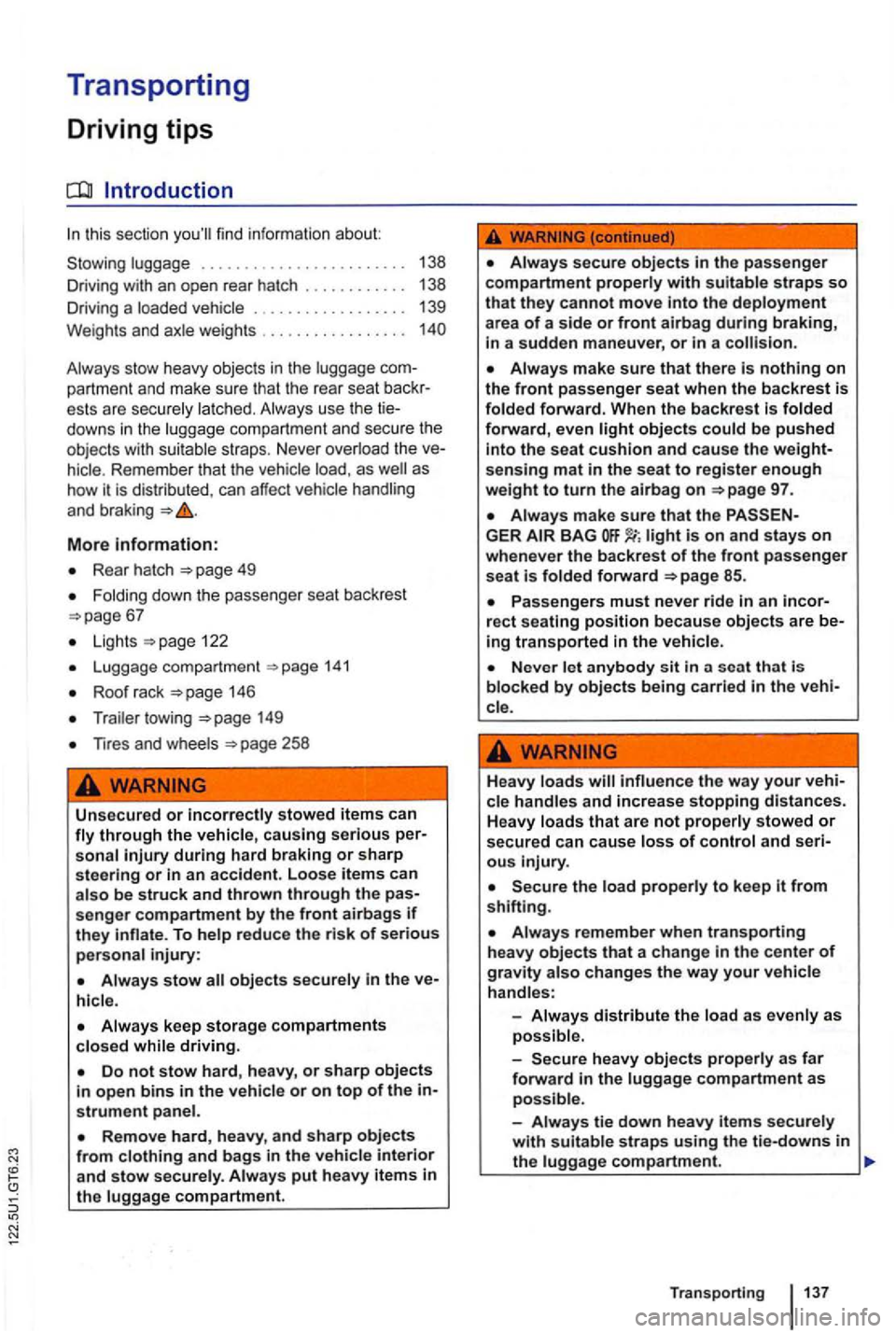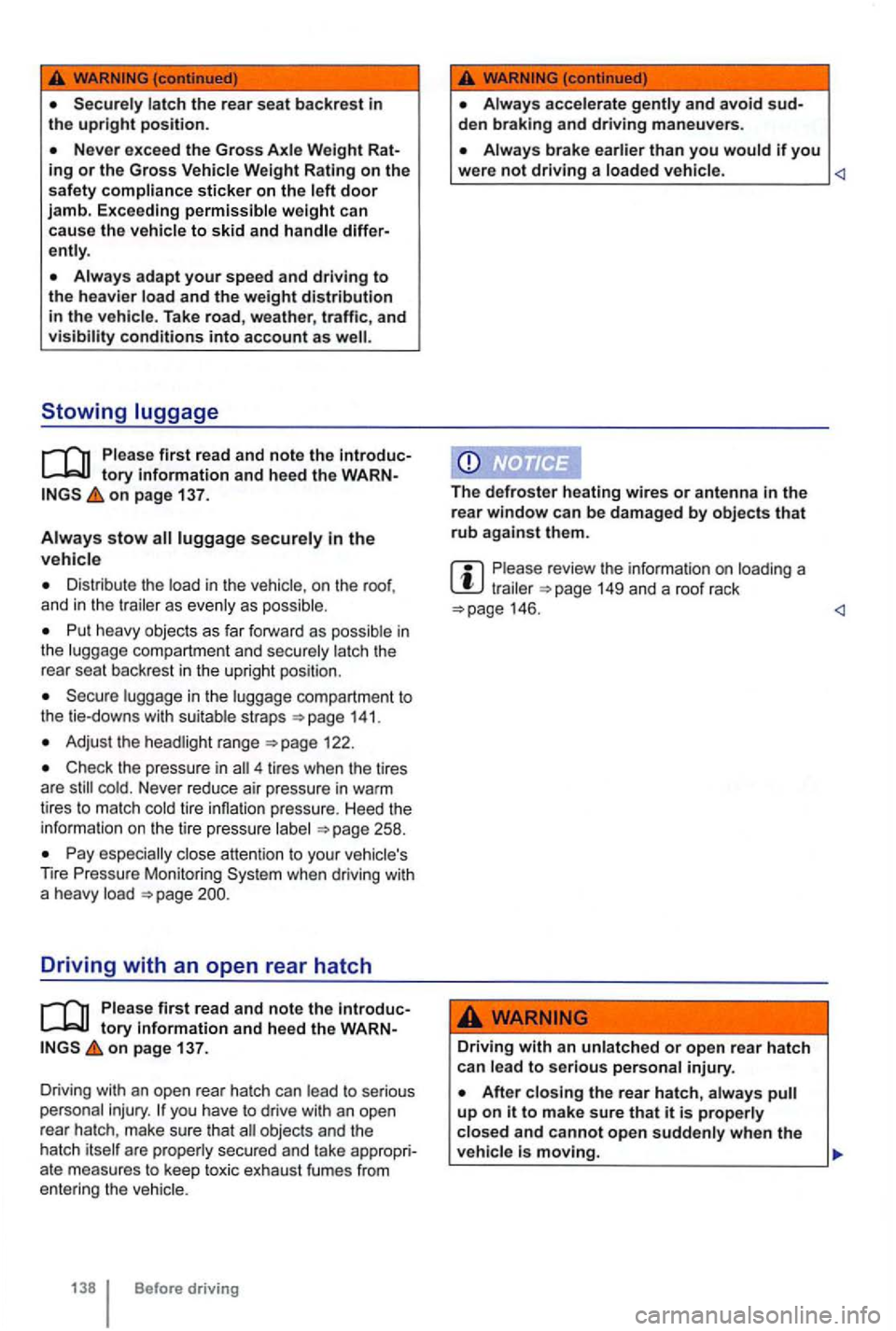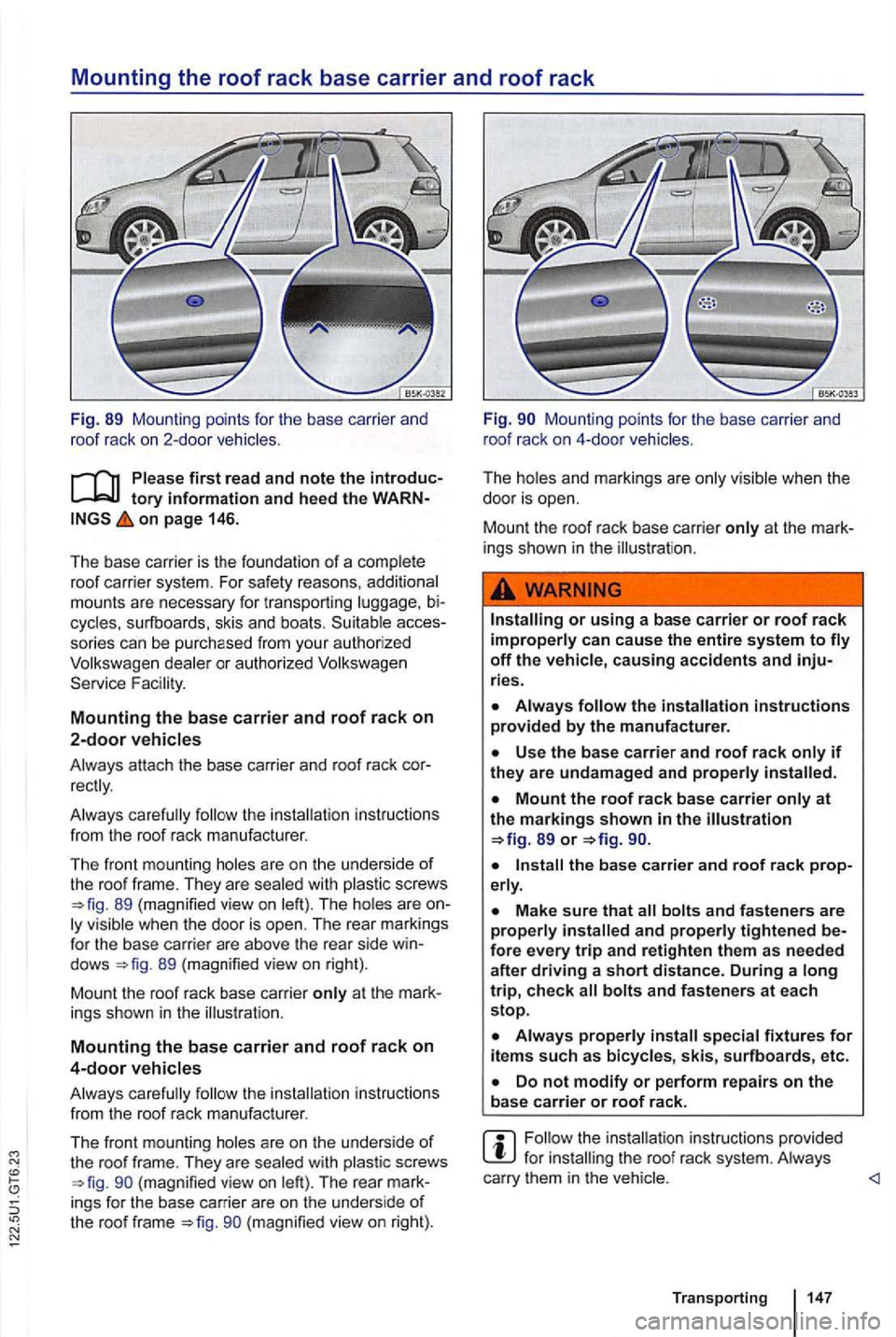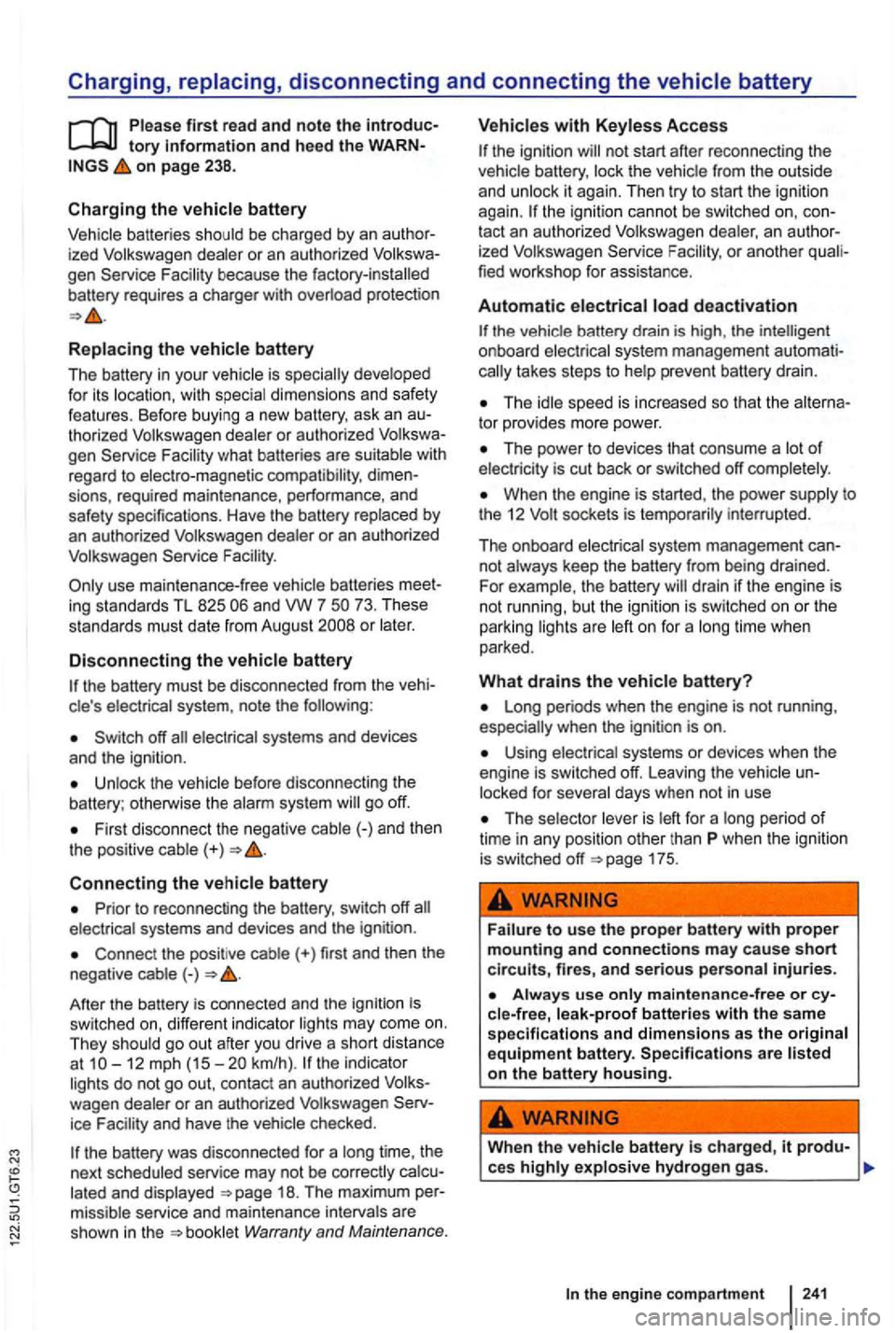Page 226 of 516
first read and note the introductory information and heed the on
is
the doors . They
compartment
The compartments may have that come on automatically when they are
opened and go off when they are
Background
When the ignition and are switched on,
the roof buttons up. There
may
be
go out when you the or a few minutes after
you remove the to prevent unnecessary drain on the battery .
Lights and vision
Page 236 of 516

Transporting
Driving tips
this sectio n
Always stow heavy objects in the luggage partment and make sure tha t the rear seat ests are securely latched. Always use the downs in the luggage compartment and secu re th e
ob jects with suita ble straps. Neve r ove rload the
hic le . R emember that the vehicle load, as
More information:
Rear hatch 49
Folding down the passenger seat backrest
Lights page 122
Luggage compartment 141
Roof rack 146
Trailer towing 149
Tires and wheels 258
Unsec ured or incorrectly stowed items can fly through the vehicle, causing serious
senger compartment by the front airbags if they To help reduce the risk of se riou s
per sonal injury:
strument panel.
nothing on
the front passenger seat when the backrest is folded forward. When the backrest is folded
forward, even
85.
scat that is
blocked by objects being carried
H eavy loads will cle handle s and increase stopping distances.
Heavy lo ads that are not properly stowed or secured can cause loss of control and ous injury.
the luggage compartment as possible.
-
Always tie down h eavy items securely with su itabl e strap s using the tie-downs in the luggage compartment.
Tran sporting
Page 237 of 516

Never exceed the Gross Axle Weight ing or the Gross
Always adapt your speed and driving to
the heavier load and the weight distribution in the vehicle . Take road, weather , traffic, and visibility conditions into account as
Please first read and note the tory information and heed the on page 137.
Always stow luggage securely in the
Distribute the load in the vehicle, on the roo f,
and in the trailer as evenly as possible .
Put heavy objec ts as far forward as possib le in
the luggage compartmen t and securely latc h t he
rear seat backrest in the upright position .
luggage in the luggage compartmen t to
the tie-downs with su itable straps
Adjust the headlig ht range 122 .
Check the pressure in 4 tires when the tires
are
P ay especially close att enti on to your vehicle 's Tire Pressu re M on itoring
Driving with an open rear hatch
tory information and heed the on page 137.
D rivi ng with
an ope n rear hatch can lead to se riou s
personal injury. if you have to drive with an ope n
rear hatc h, make sure t hat objec ts and the
hatch it sel f are properly secured and take
Before d riving
den braking and driving maneuvers .
Always brake earlier than you would if you were not driving a loaded vehicle. <1
The defroster heating wires or antenna in the rear window can be damag ed by objects that rub against them.
Please review the in forma tion on loadi ng a tr ai le r 149 and a roof rack 146. <1
Driving with a n unlatched or open rear hatch
ca n lead to serious personal injury.
After clo sing the rear hatch, always
Page 245 of 516

Roof rack
Introduction
this sectio n find informa tion about:
Mo unt in g the roof rack base carrier and roof
rack
................................... 147
Securing a load on the roof rack . . . . . . . . . . . 148
The ro of o f your vehicle has been designed to
approv ed base carrie r mounts and roof racks can
be used .
When should the roof rack be removed?
When it is no longer needed .
Before driving through an automatic car was h.
When the vehic le wou ld otherwise be too high
t o ach ieve min imum clearanc e to enter, for
ple, a garage .
More information:
Lights
Transporting 137
Saving fuel and helping the envi ronment
Tires and wheels 258
283
Transporting heavy or bulky loads on the roof rack will change the way the vehicle handles by shifting the vehicle's center of gravity and
increasing the wind drag area.
146 Before driving
able and undam ag ed straps so that the load
have a negative effect on the vehicle's
aerodynamics , center of gravity and ove rall
Your vehicle is higher when the roof rack is installed , especially when it is loaded. Compare
the vehicl e he ight with existing clear ance
heights , such as underpasses and garage doors.
creases due to increased air resis ta nce.
Page 246 of 516

Mounting the roof rack base carrier an d roof rack
Fig . 89 Mounting points for the base carrier and
r oof rack on 2-door vehicles .
on page 146.
Th e base carrier is th e foundation
of a complet e
roof carrier sys te m . For safety reasons , additi onal
mount s are necessary for tran spor ting luggage,
cycles , s urfb oards, skis and boats . sories can be purchased from your auth orized Volk swage n dea ler or autho rized Volkswagen
Mounting the base carrier and roof rack on
2-door vehicles
Always attach th e base carrier and roof rack
A lways the instruct ions
f r om the roof r ack manuf acture r.
T he fr o nt mount ing holes are on
the unders ide of
t he roo f frame . Th ey are sealed with plastic screws 89 (magnified view on left). The ho les are
do ws 89 (magn ified view on right).
Mou nt the roof ra ck base carrier only a t the ings sh ow n in the
Mounting the base carrier and roof rack on 4-door vehicles
Always instructions
from the roof r ack manufacturer.
The fr ont mounting holes are on the underside
of the roof frame . They are sealed with plastic screws (magnified view on left) . Th e rear ings for the base carrier are on the unders ide of the roof frame (magnified view on right). Fig
.
ings sh own in the
the instructions provided by the manufacturer.
fig.
fore every trip and retighten them as needed
after driving a short distance. During a long trip, check bolts and fasteners at each stop.
for the roof rack system . A lways
carry them in the veh icle.
Transporting 147
Page 247 of 516
Securing a load on the roof rack
first read and note the introduc
on page 146.
to sec ure a the roof rack sys tem has been
Maximum
The maximum roof is 165 (75 kg). T he roof
Be sure you know the weight of the roof rack and the items you want to transp ort on the roof. Weigh
them if n ecessary . N ever carry a roof
When using a roof rack with a do
not
this case , you may the
r oof rack to the weight
Distribut e the
Checking the mountings
After the base carrier and rook rack have been incheck and fasteners after driv in g a
short time and at
Before driving
damag e may occur.
the
maximum gross weight rating .
Do not exceed the roof
make sure that are
use u ndam aged tie-down ropes and ratche t straps .
the
Page 310 of 516
The air conditioner is most efficient when the win
dows and the power sunroof are closed.
Page 340 of 516

Charging,
on page 238.
Charging the vehicle battery
Vehicle batteries should be charged by an author
ized Volkswagen dealer or an authorized Volkswa
gen
because the factory -installed
battery requires a charger with overload protection
Replacing the vehicle battery
The battery in your vehicle is
batteries meet
ing standards TL 825
electrical system, note the following :
off
Unlock the vehicle before disconnecting the
battery; otherwise the alarm system
Fir st disconnect the negativ e cable(-) and then the positive
Connecting the vehicle battery
Pr ior to reconnecting the battery , switch off electrical sys tems and devices and the ignition .
Connect the posit ive cable(+) first and then the
negative cable (-)
After the battery is connected and the ignition is
sw itched on, different indicator light s may come on. They should go out after you drive a short distance
ice Facility and have the checked.
th e ign ition not start after reconnecting the vehicle battery , lock the vehic le from the outside
and unlock it again. Then try to start the ignition
again.
lhe ignition cannot be switched on, con
tact an authorized Volkswagen dealer, an author
ized Volkswagen
o r another quali
fied workshop for assistance.
Automatic electrical load deactivation
onboard electrical system management auto mati takes steps to help prevent battery drain.
The idle speed is increa sed so that the alterna
t o r provides more power.
Th e power to devices that consume a lot of electricity is cut back or switched off completely.
When the engine is started, the power supply to the 12
Long periods when the engine is not running,
especially when the ignition is on .
Using electr ical sys tems or devices when the
engine is swi tched off. Leaving the
The selecto r lever is left for a long period of time in any position other than P when the ignition
is swi tched off =>page 175.
Failure to use th e proper battery with proper mounting and connection s may cause short circu its, fires, and serious persona l injuries.
Always use only maintenance-free or cy-
cle-free, leak-proof batteries with the sa me
s p ec ifications and dimensions as the original
equipment b attery. Specifications are listed
on the battery housing.
Wh en the vehicle battery is ch arged, it produ-
ces highly explosive hydroge n gas.
th e engine compartment